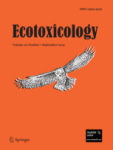Toxicity data for modeling impacts of oil components in an Arctic ecosystem
Toxicity data for modeling impacts of oil components in an Arctic ecosystem
 Today, modeling has become an invaluable tool to extrapolate impacts of toxicants from an individual to the population level. As such, it is essential for ecosystem-based approaches to impact assessment. For modelling purposes, this study synthesized available literature on the effects of petroleum related discharges on selected cold-water marine species (plankton and fish). The resulting dataset is to be used by ecotoxicology algorithms included in an ecosystem-based modeling system that combines both ecological and toxicological knowledge into a single modeling framework. We believe this study is of general value to the ecotoxicology community in two ways: first, the assembled data are of use to others engaged in the development and/or application of ecotoxicology models. Second, the results indicate where further ecotoxicology research will be of greatest value for both increasing general knowledge on cold-water ecotoxicology and for designing new ecotoxicology studies for modeling applications.
Today, modeling has become an invaluable tool to extrapolate impacts of toxicants from an individual to the population level. As such, it is essential for ecosystem-based approaches to impact assessment. For modelling purposes, this study synthesized available literature on the effects of petroleum related discharges on selected cold-water marine species (plankton and fish). The resulting dataset is to be used by ecotoxicology algorithms included in an ecosystem-based modeling system that combines both ecological and toxicological knowledge into a single modeling framework. We believe this study is of general value to the ecotoxicology community in two ways: first, the assembled data are of use to others engaged in the development and/or application of ecotoxicology models. Second, the results indicate where further ecotoxicology research will be of greatest value for both increasing general knowledge on cold-water ecotoxicology and for designing new ecotoxicology studies for modeling applications.
Scientific abstract
Ecological impact assessment modeling systems are valuable support tools for managing impacts from commercial activities on marine habitats and species. The inclusion of toxic effects modeling in these systems is predicated on the availability and quality of ecotoxicology data. Here we report on a data gathering exercise to obtain toxic effects data on oil compounds for a selection of cold-water marine species of fish and plankton associated with the Barents Sea ecosystem. Effects data were collated from historical and contemporary literature resources for the endpoints mortality, development, growth, bioaccumulation and reproduction. Evaluating the utility and applicability of these data for modeling, we find that data coverage is limited to a sub-set of the required endpoints. There is a need for new experimental studies for zooplankton focused on the endpoints development and bioaccumulation and for larvae and juvenile fish focused on growth and development.
Full reference (link)
Olsen G. H., Klok C., Hendriks A.J., Geraudie P., De Hoop L., De Laender F., Farmen E., Grøsvik B.E., Hansen B.H., Hjorth M, Jansen CR., Nordtug T., Ravagnan E., Viaene K., Carroll J. (2013) Toxicity data for modeling impacts of oil components in an Arctic ecosystem. Marine Environmental Research 90: 9-17.
